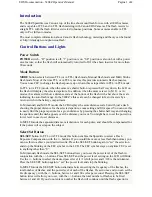4-26
|
Chapter 4 Operation, Maintenance and Reference
Surveyor MKII HD Network Dome
Network Cable
Caution
Careful selection of proper cable is essential to obtain the best performance.
Vicon assumes no responsibility for poor performance when cables other
than the recommended types, or equivalent, are used. Vicon recommends
using shielded cable.
Materials
Use pure copper stranded conductors to obtain a low DC resistance. The preferred
insulation and cable jacket is Polyvinyl chloride (PVC). It has better electrical
characteristics than Polyethylene and resists flames, sunlight and most solvents, but is
more vulnerable to moisture.
Cable Types
The most commonly used cable types are CAT5, CAT5e and CAT6. These category
cables are best suited for Ethernet network applications.
Choose a Belden cable type by referring to the characteristics listed below. The Table
below should be used as a guideline when cables other than Belden are used. Materials
and construction must follow the guidelines above.
CABLE TYPE
WIRE SIZE
(AWG)
INSULATION
MATERIAL
JACKET
MATERIAL
CATEGORY
BANDWIDTH
(MHz)
MAXIMUM
DISTANCE
(ft/m)
NUMBER OF
TWISTED
PAIRS
Belden 1624P
(Shielded)
24
Fluorinated
Ethylene
Propylene
Low Smoke
PVC
5
100
246/75
4
Belden Inc.
http://www.belden.com/ (800) 235-3361
Alarm/Relay Cable
Materials
Use a pure copper stranded conductor with or without a tin-plating to obtain a low DC
resistance. Do not use cable with either steel or aluminum stranded conductor because they
do not transfer signals effectively for long distances. The preferred insulation and cable
jacket is Polyvinyl chloride (PVC). It has better electrical characteristics than polyethylene
and resists flames, sunlight and most solvents, but is more vulnerable to moisture.
Cable Types
The most commonly used cable types are dual individually twisted pair in a single jacket.
This configuration is the most convenient for the alarm/relay signal applications. Single
twisted pair is also a suitable cable.


















